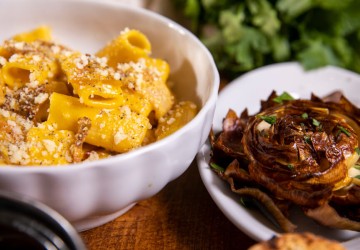Italian cuisine is very vast and each region has its own typical dishes that represent it. Visiting a new destination also means savoring its culinary culture made of traditional recipes that are handed down from generation to generation.
Rome boasts a wide range of traditional dishes to try absolutely to know the Eternal City at 360 º and appease hunger after several excursions to discover the city. Roman cuisine is a poor cuisine, made of simple ingredients but with an intense taste.
→ Discover our Destination Eataly bus tour
Typical Roman foods to try
Here is our guide to the 10 best Roman foods to try:
- Pasta alla Carbonara
Pasta alla carbonara is certainly the typical dish par excellence of Roman cuisine. The eggs are mixed with pecorino romano and continue mixing vigorously with whips until you get a cream. To the softness of the cream is added the crispness of the local pillow for a unique dish of its kind.
No one knows the true story of his origins. There are those who trace it back to the Carbonai (Carbonari in Roman), some to the American soldiers during the Second World War. But one thing is certain: the best carbonara is in Rome!
→ Recommended location: Roscioli, via dei Giubbonari 21 - Tonnarelli cacio e pepe
The tonnarelli cheese and pepper are served with a creamy sauce of pecorino cheese and black pepper. Despite the simplicity of the ingredients, it is a very difficult dish to replicate at home, because of its procedure: the cheese and pepper are combined with the cooked pasta and a little of its cooking water and mixed vigorously to create a sauce.
The dish originates from the shepherds, who during their travels brought with them simple ingredients such as pepper and sheep cheese. When hunger began to be felt, the shepherds cooked pasta on a field fire and added cheese and black pepper, stirring vigorously. It was thus that the dish was born that still today is very successful in the late Roman.
→ Recommended location: Tonnarello, Via della Paglia, 1/2/3 - Gricia e Amatriciana
Pasta alla gricia is basically a carbonara without eggs. However, the gricia has more ancient origins than the carbonara, which is a more modern dish.
The ingredients are 3: pecorino romano, black pepper, and pillow that make the dish creamy and tasty.
→ Recommended location: Cesare al Casaletto, Via del Casaletto, 45
Amatriciana is considered the gricia with cherry tomatoes. Its name is linked to the city of Amatrice, known for the quality of its pillow but remains a typical Roman dish.
With the debut of tomatoes in Italian cuisine, combined with classic Roman ingredients such as guanciale and pecorino cheese, it has created a dish similar to gricia but with its uniqueness and pleasantness.
→ Recommended location: Osteria Fernanda, Via Crescenzo Del Monte 18/ 24
- Abbacchio alla scottadito
Abbacchio alla scottadito is a typical dish of the Easter period but it is also consumed in everyday life. The lamb is a young lamb with a delicate flavor, in this traditional recipe lamb chops are first marinated and then grilled.
The term scottadito indicates the characteristic of the dish, that is to taste it when it is still hot, slightly scalding your fingers.
→ Recommended location: Hostaria Isidoro, Via di S. Giovanni in Laterano, 59/A - Coda alla vaccinara
This dish also known as "Quinto Quarto" consists of a stew of oxtail refers to the entrails (what remains of the animal after removing the two front and rear parts).
Its origins can be traced back to the Rione Regola whose inhabitants were known as code eaters (queue eaters).
Oxtail is cooked with onions, carrots, plenty of celery, wine, tomatoes and occasionally raisins and pine nuts. Cooking is very slow and takes at least 4-5 hours.
→ Recommended location: Trattoria Da Enzo al 29, via dei Vascellari 29 - Artichokes to the Giudia and the Roman
The artichokes alla giudia are artichokes in perfect Jewish style (of the Ghetto of Rome). They are previously immersed in water and lemon and then fried in abundant oil.
Another typical recipe for this vegetable is artichoke alla romana. Unlike those alla giudia, in this recipe artichokes are not fried but cooked in a pan and filled with garlic, parsley, and mint.
→ Recommended location: Armando al Pantheon, salita de’ Crescenzi 31
- Cicoria ripassata
The cicoria is a green vegetable with a slightly bitter taste.
The cicoria ripassata is a side dish of Lazio cuisine simple and rich in taste. The cicoria is previously boiled and then re-cooked on the fire in abundant oil, garlic, and parsley.
→ Recommended location: Trattoria La Rustica, Via Bolgheri 55 - Trapizzino
Trapizzino was invented by Stefano Callegari in 2009. The famous pizza maker has combined the love for pizza with the typical Roman savory dishes.
It is a pocket of white pizza closed on the sides that can contain: chicken cacciatora, tripe Roman, meatballs with sauce, and much more.
The trapizzino can be enjoyed in Testaccio and other places in Rome but also in many Italian cities such as Milan and Turin. Until you get to land abroad, precisely in New York.
→ Recommended location: Mercato Centrale, Via Giovanni Giolitti 36 - Maritozzo
In Roman times, the maritozzo was a sweet bread whose inside was inserted a ring or another golden object, which the man gave to his future wife as a token of love.
The Maritozzo Romano is a sweet leavened sandwich filled with cream and covered with a sprinkling of powdered sugar. Another tasty variation is the salty maritozzi perfect for a lunch break or for a delicious aperitif. We find all tastes: amatriciana, mortadella, culatello, and much more.
→ Recommended location: Regoli, storica panetteria near Piazza Vittorio - Crostata di visciole
The sour cherry tart is sweet of the Jewish-Roman tradition: a soft shortcrust pastry covered with sour cherry jam and a layer of ricotta cream. Sour cherries are a type of cherry with a red appearance and a slightly sour taste.
The origins of sweet-sour cherries date back to the eighteenth century. At the time, some papal edicts forbade the sale of dairy products and bakers began to hide the ricotta cheese between two layers of shortcrust pastry covered with sour cherries.
→ Recommended location: Forno Boccione to the Ghetto

